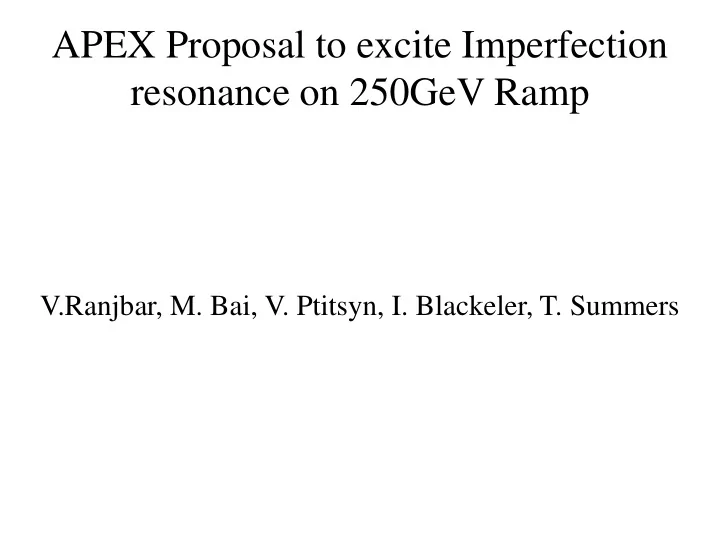

APEX Proposal to excite Imperfection resonance on 250GeV Ramp V.Ranjbar, M. Bai, V. Ptitsyn, I. Blackeler, T. Summers
To Prepare for APEX study of Imperfection Resonances impact on Polarization, I created A matlab program to perform DEPOL Imperfection resonance calculation. I then used this Program to perform a response matrix calculation relating correctors to the real and Imaginary part of the resonance strength. With this response matrix we can then construct a set of correctors to perturb the resonance in a precise manner. For example we constructed a new matlab function to return the corrector strengths necessary to achieve a given Delta in the imperfection resonance while keeping the surrounding resonances unperturbed. An example of how we would use this function is shown below: % load the lattice for this we are using an error free lattice but this works with a % misaligned lattice as well Blue3; % Define initial GGAMA resonance location we want to kill GGAMI = 374; % Define final GGAMA resonance location we want to kill GGAMF = 390; % The Target resonance GGAMT = 380; % the amount we want to perturb the resonance can be real and imaginary DW = 0.1 % Use my findDtheta function to return the corrector strengths theta = findDtheta(THERING,GGAMI,GGAMF,GGAMT,DW); % apply the corrector strengths to the lattice CORRV = findcells(THERING,'FamName','KICKV'); for j=1:length(CORRV) THERING{CORRV(j)}.KickAngle = THERING{CORRV(j)}.KickAngle - [0 theta(j)*1.0e-5]; end
% and now we check the results to make sure its doing what we want. So can repeat this exercise for the real and imaginary parts of the imperfection Resonances for several resonances around the main intrinsic resonance crossing At 411-NU and the other strong one at 393+NU. My initial tests have shown that The strength of the perturbation remains fairly constant with errors and scalable.
Now with these sets of correctors strength we can construct 'knobs' to turn On a given set of delta corrector strengths during the 411-NU resonance Crossing to alter the Imperfection resonance in a very controlled manner. Exciting just the real or imaginary part of the resonance. In this way we can Better evaluate the impact of these resonances on the polarization losses we believe Are occurring during both of these resonance crossings. As a cross check we can also measure the differential orbit an compare that to Our model to better understand if we are exciting the changes we desire. For example We see what the difference orbit should look like and even calculate and FFT:
Plans: ● Currently I am working with Ian and Al to work out the mechanics of how to get these 'knobs' working without colliding with the orbit feedback. With the large space around the perturbation we should be able to ramp up and down slowly to the targeted without any 'side-effects' ● It would be great if we could have some time to do a Orbit response Matrix measurement. Then at least I could use a model that approximated reality better. ● I am trying to finish up matlab function to save the matlab lattice models in an sxf format. In this way we can better go back and forth to spin tracking.
Recommend
More recommend